TO
Filters: Collection: "ir_eua"
| Title | Date | Subject | Description | ||
|---|---|---|---|---|---|
| 701 |
 |
Digitized log file, API Number 4304736907 | 2009 | This log was digitized by the Utah Geological Survey from image files (.tiff) compiled by the Utah Division of Oil, Gas, and Mining | |
| 702 |
 |
Digitized log file, API Number 4305120103 | 2009 | This log was digitized by the Utah Geological Survey from image files (.tiff) compiled by the Utah Division of Oil, Gas, and Mining | |
| 703 |
 |
Digitized log file, API Number 4305130001 | 2009 | This log was digitized by the Utah Geological Survey from image files (.tiff) compiled by the Utah Division of Oil, Gas, and Mining | |
| 704 |
 |
Digitized log file, API Number 4305130003 | 2009 | This log was digitized by the Utah Geological Survey from image files (.tiff) compiled by the Utah Division of Oil, Gas, and Mining | |
| 705 |
 |
Digitized log file, Utah Geological Survey Well Number U043 | 2009 | This log was digitized by the Utah Geological Survey from image files (.tiff) compiled by the Utah Division of Oil, Gas, and Mining | |
| 706 |
 |
Digitized log file, Utah Geological Survey Well Number U044 | 2009 | This log was digitized by the Utah Geological Survey from image files (.tiff) compiled by the Utah Division of Oil, Gas, and Mining | |
| 707 |
 |
Digitized log file, Utah Geological Survey Well Number U045 | 2009 | This log was digitized by the Utah Geological Survey from image files (.tiff) compiled by the Utah Division of Oil, Gas, and Mining | |
| 708 |
 |
Digitized log file, Utah Geological Survey Well Number U046 | 2009 | well log; Utah Geological Survey | This log was digitized by the Utah Geological Survey from image files (.tiff) compiled by the Utah Division of Oil, Gas, and Mining |
| 709 |
 |
Digitized log file, Utah Geological Survey Well Number U048 | 2009 | This log was digitized by the Utah Geological Survey from image files (.tiff) compiled by the Utah Division of Oil, Gas, and Mining | |
| 710 |
 |
Digitized log file, Utah Geological Survey Well Number U050 | 2009 | This log was digitized by the Utah Geological Survey from image files (.tiff) compiled by the Utah Division of Oil, Gas, and Mining | |
| 711 |
 |
Digitized log file, Utah Geological Survey Well Number U054 | 2009 | This log was digitized by the Utah Geological Survey from image files (.tiff) compiled by the Utah Division of Oil, Gas, and Mining | |
| 712 |
 |
Digitized log file, Utah Geological Survey Well Number U056 | 2008 | This log was digitized by the Utah Geological Survey from image files (.tiff) compiled by the Utah Division of Oil, Gas, and Mining | |
| 713 |
 |
Digitized log file, Utah Geological Survey Well Number U059 | 2009 | This log was digitized by the Utah Geological Survey from image files (.tiff) compiled by the Utah Division of Oil, Gas, and Mining | |
| 714 |
 |
Digitized log file, Utah Geological Survey Well Number U060 | 2009 | This log was digitized by the Utah Geological Survey from image files (.tiff) compiled by the Utah Division of Oil, Gas, and Mining | |
| 715 |
 |
Digitized log file, Utah Geological Survey Well Number U061 | 2008 | This log was digitized by the Utah Geological Survey from image files (.tiff) compiled by the Utah Division of Oil, Gas, and Mining | |
| 716 |
 |
Digitized log file, Utah Geological Survey Well Number U062 | 2008 | This log was digitized by the Utah Geological Survey from image files (.tiff) compiled by the Utah Division of Oil, Gas, and Mining | |
| 717 |
 |
Digitized log file, Utah Geological Survey Well Number U064 | 2009 | Utah Geological Survey; well log; well U064 | This log was digitized by the Utah Geological Survey from image files (.tiff) compiled by the Utah Division of Oil, Gas, and Mining |
| 718 |
 |
Digitized log file, Utah Geological Survey Well Number U065 | 2009 | This log was digitized by the Utah Geological Survey from image files (.tiff) compiled by the Utah Division of Oil, Gas, and Mining | |
| 719 |
 |
Digitized log file, Utah Geological Survey Well Number U068 | 2009 | well log; well U068; Utah Geological Survey | This log was digitized by the Utah Geological Survey from image files (.tiff) compiled by the Utah Division of Oil, Gas, and Mining |
| 720 |
 |
Digitized log file, Utah Geological Survey Well Number U081 | 2009 | This log was digitized by the Utah Geological Survey from image files (.tiff) compiled by the Utah Division of Oil, Gas, and Mining | |
| 721 |
 |
Digitized log file, Utah Geological Survey Well Number U082 | 2009 | This log was digitized by the Utah Geological Survey from image files (.tiff) compiled by the Utah Division of Oil, Gas, and Mining | |
| 722 |
 |
Digitized log file, Utah Geological Survey Well Number U085 | 2009 | This log was digitized by the Utah Geological Survey from image files (.tiff) compiled by the Utah Division of Oil, Gas, and Mining | |
| 723 |
 |
Digitized log file, Utah Geological Survey Well Number U086 | 2009 | This log was digitized by the Utah Geological Survey from image files (.tiff) compiled by the Utah Division of Oil, Gas, and Mining | |
| 724 |
 |
Digitized log file, Utah Geological Survey Well Number U092 | 2009 | This log was digitized by the Utah Geological Survey from image files (.tiff) compiled by the Utah Division of Oil, Gas, and Mining | |
| 725 |
 |
Digitized log file, Utah Geological Survey Well Number U102 | 2009 | This log was digitized by the Utah Geological Survey from image files (.tiff) compiled by the Utah Division of Oil, Gas, and Mining | |
| 726 |
 |
Digitized log file, Utah Geological Survey Well Number U108 | 2009 | This log was digitized by the Utah Geological Survey from image files (.tiff) compiled by the Utah Division of Oil, Gas, and Mining | |
| 727 |
 |
Digitized log file, Utah Geological Survey Well Number U111 | 2009 | This log was digitized by the Utah Geological Survey from image files (.tiff) compiled by the Utah Division of Oil, Gas, and Mining | |
| 728 |
 |
Digitized log file, Utah Geological Survey Well Number U138 | 2009 | This log was digitized by the Utah Geological Survey from image files (.tiff) compiled by the Utah Division of Oil, Gas, and Mining | |
| 729 |
 |
Digitized log file, Utah Geological Survey Well Number U149 | 2009 | This log was digitized by the Utah Geological Survey from image files (.tiff) compiled by the Utah Division of Oil, Gas, and Mining. | |
| 730 |
 |
Digitized log file, Utah Geological Survey Well Number U153 | 2009 | This log was digitized by the Utah Geological Survey from image files (.tiff) compiled by the Utah Division of Oil, Gas, and Mining. | |
| 731 |
 |
Diluent-assisted hot-water processing of tar sands | 1987 | hot water processing; tar sands; diluent-assisted hot-water processing; bitumen viscosity | The influence of diluent addition and temperature on bitumen viscosity of tar sands from nine locations in the U.S.A. and Canada has been investigated. Subsequently, hot-water bitumen-recovery experiments were carried out at temperatures from 33°C to 95°C. Kerosene was added as needed to maintain ... |
| 732 |
 |
Dilution centrifuging of bitumen froth from the hot water process for tar sand | 1983-05-17 | Patent; Dilution centrifuging; Bitumen froth; Tar sand; Naphtha-diluted bitumen froth | In the known operation wherein naphtha-diluted bitumen froth is pumped from a scroll-type centrifugal separator to a disc-type centrifugal separator, an improved pumping system is provided. The system comprises at least two centrifugal pumps in series, each operating preferably at an impellor tip sp... |
| 733 |
 |
Dimensions, exterior surfaces, volumes, densities and shape factors for particles of crushed Colorado oil shale in two narrow sieve fractions (Abstract) | 1981-09-29 | Colorado oil shale; oil shale; narrow sieve fractions; large-scale oil extraction; factors of oil-shale particles; oil shale particles | Large-scale extraction of oil from Colorado oil shale will require that the rock be fragmented for heat processing, whether the retorting be done above or below ground level. Understanding of fluid friction, heat transfer and mass transfer in beds of shale particles requires that we be able to char... |
| 734 |
 |
Directory of State of Utah statistics 1971 | 1971-09 | The Directory of State of Utah Statistics has been developed in response to the need for a fairly comprehensive guide to statistical information published by the State. The Directory is intended to fulfill two objectives. The first and major objective is to make available to policy makers, planners ... | |
| 735 |
 |
The disposition of sulfur during the oxidation and subsequent leaching of retorted oil shale | 1982-03 | sulfur; oxidation of oil shale; leaching of retorted oil shale; retorted oil shale; oil shale; char | The char and iron sulfides in retorted oil shale were oxidized at temperatures from 350 to 800°C. At temperatures above approximately 550°C, sulfur was retained by the shale as water-soluble sulfates, whereas oxidation at temperatures between 400 and 500°C resulted in a loss of as much as 22% of ... |
| 736 |
 |
Division of oil, gas, and mining permitting processes | 2011-05-17 | permitting processes; natural resources; oil; gas; mining | Division of Oil, Gas, and Mining Permitting Processes. John Baza, DirectorUtah Division ofOil, Gas and Mining. Unconventional Fuels Conference. May 17, 2011 |
| 737 |
 |
DOE project review: Subtask 4.2 (B): Examination of in situ production models | 2011-03-11 | DOE project review; in situ production models; oil shale; unconventional fuels; oil sands; geomechanics; general reservoir simulation tool | A presentation given at the Unconventional Fuels from Oil Shale and Oil Sands Project Review Meeting on March 10-11, 2011. The objectives of the presentation is the examination of in-situ production methods, different in-situ production method options, rigorous energy and carbon balances, exploratio... |
| 738 |
 |
Domestic tar sands and potential recovery methods--a review | 1969-12 | The purpose of this paper is to review and evaluate present knowledge of United States tar sands including physical properties, occurrence, reserves, and recovery methods. Tar sands are oil, bitumen, asphalt, tar, or petroleum-impregnated rock from which little hydrocarbon material is recoverable by... | |
| 739 |
 |
Double solvent extraction of organic constituents from tar sands | 1977-09-06 | Extraction of hydrocarbons from tar sands with a light naphtha/methanol solvent system results in rapid decrepitation of the tar-sand aggregate and separation of organic matter into three phases. Distribution of the extracted and non-extracted organic material is among the phases. The most desirable... | |
| 740 |
 |
Dow shale site tracer gas pressurization study | 1977-10 | Systems, Science and Software (S3) has developed tracer gas/ pressurization techniques necessary to determine critical media properties of underground regions. Application of this technology is especially relevant to analysis of an oil shale retort volume. During the period 7 July to 14 July 1977, a... | |
| 741 |
 |
Downhole hydraulic mining system | 1985-07-31 | Oil-bearing sands; Oil field; Wellbore; Downhole hydraulic mining system; California; Utah; Kentucky; New Mexico; Canada; Venezuela; Oil; Deposits; Strip mining | The downhole hydraulic mining system is designed to exploit deposits of oil-bearing sands that are not economically producible using current oil field or mining technology. In most cases, the hydrocarbon in the reservoir is too viscous to flow into the wellbore naturally and applications of heat (st... |
| 742 |
 |
Draft environmental impact statement on conversion of oil and gas leases to combined hydrocarbon leases, Tar Sand Triangle, Utah | 1984-07-16 | The Draft Environmental Impact Statement will provide the Regional Director, National Park Service, and State Director, Bureau of Land Management, with the necessary information to make a decision on whether existing oil and gas leases in Glen Canyon National Recreation Area and on adjacent BLM land... | |
| 743 |
 |
Duplex: lessons learned and roadblocks overcome to its success | DuplexTM is an innovative combustion technology that has been successfully implemented in a variety of industrial applications including refinery process heaters, once-through steam generators, enclosed flares and boilers. The technology provides unparalleled environmental and process performance ch... | ||
| 744 |
 |
Earth Energy Resources corporate presentation | 2008-02-22 | Oil sands; Earth Energy; Ophus Process; PR Spring, Utah; Bitumen; Oil sand mining; Tailings ponds; Extraction processes; Utah; Water consumption; Athabasca, Canada; Vernal, Utah; Simplot Phosphate Mine | Forward looking statements--Earth Energy Resources, Inc.: This presentation and the Company's website referenced in this presentation contain forward-looking statements including expectations of future production and components of cash flow and earnings. Investors are cautioned that assumptions used... |
| 745 |
 |
Earth Energy Resources Inc. | 2006-09-21 | Uinta Basin; Oil sands; Athabasca; Tailings ponds; Water usage and supply; Emulsion treating; Concurrent Reclamation; Natural Gas; Process heating fuel; Infrastructure; Product transportation; Production issues; Ophus Process; Bitumen; Tar sand; Utah | Issues facing oil sand production: -Issues facing Athabasca producers -Likely issues facing Uinta Basin producers -Technology advancements will provide the keys to unlock the oil sands in the USA |
| 746 |
 |
Earth Energy Resources, Inc. oil sands production in Utah: Continued development | 2009-02-27 | Oil Sand; Utah; Hydrocarbon Energy Environmental Gap; HEEG; Earth Energy; Oil sand production; Ophus Process; Oil sand deposits; Bitumen extraction; Oil sand mining; EER Spring Mine Site; Vernal, Utah | Overview of Earth Energy Resources, Inc.'s continuing oil sands development activities in Utah, presented at the 2009 Western U.S. Oil Sands Conference by D. Glen Snarr, President & Chief Financial Officer, Earth Energy Resources, Inc. |
| 747 |
 |
EC sensor: flame safety and fuel savings integrated into one system | Safety is the most important consideration in the operation of any combustion system. To that effect, operators of combustion equipment monitor the presence of a flame in various ways. The most common flame monitoring sensors include flame rods, infrared scanners and ultra-violet scanners. Although ... | ||
| 748 |
 |
Economic & demographic futures 1980-2000 | 1980-01 | Special acknowledgement is appropriate for the efforts of the Community Planning Policy Committee which provided continual guidance to the Water Quality staff over a six month period; in addition to Jean Watanbe, Office of the State Planning Coordinator, Brad Barber and Greg Selby formerly with the ... | |
| 749 |
 |
The economic & demographic impacts of the intermountain power project | 1982-04 | This report presents economic and demographic projections for the two-county (Millard and Juab) area to be impacted by the Intermountain Power Project located in western Millard County, Utah. The intermountain Power Agency has been planning the construction of the IPP project for quite some time. | |
| 750 |
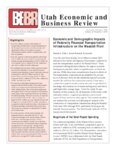 |
Economic and demographic impacts of federally financed transportation infrastructure on the Wasatch Front | 2004-09 | Over the next three decades, $14.4 billion (constant 2004 dollars) of new transit and highway infrastructure is planned to meet the transportation needs of the Wasatch Front.1 These investments will significantly influence the region's economic development potential, relative competitiveness, and la... | |
| 751 |
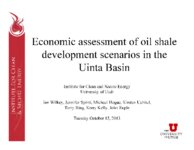 |
Economic assessment of oil shale development scenarios in the Uinta Basin | 2013-10-15 | Economic assessment; Oil shale development; Uinta Basin; In situ; Ex situ | |
| 752 |
 |
Economic comparison of the thermal and hot-water process for recovery of oil from tar sands | 1978-11 | A comparison of the economics of the Hot Water and Thermal Process for recovery of oil from the tar sands at Sunnyside is presented using a plant size of 25,000 B/D of hydrocarbon products. The Thermal Process will require an investment of approximately $120,000,000. The product is a low viscosity f... | |
| 753 |
 |
Economic evaluation of oil shale and tar sands resources located in the state of Utah: Phase 1 | 1981-02-15 | Managing public lands for maximum social benefit is becoming an increasingly complex task. The growing need for domestically produced mineral raw materials and energy, and the conflicting interests over the use of public lands, have added new dimensions to the management issues. This report covers t... | |
| 754 |
 |
Economic evaluation of oil shale and tar sands resources located in the state of Utah: Phase 2 | 1982-10 | Technically accurate economic evaluation of Utah resources is essential to the future health of Utah's economy and for the sound management of Utah's lands and mineral/hydrocarbon resources. This report presents the results of the second year of research aimed at resources in the State of Utah. The ... | |
| 755 |
 |
Economic impact of synthetic fuels and M-X development on small business in the four corners region | 1981-06 | The development of asynthetic fuels industry and the deployment of the M-X nuclear weapons station within the Four Corners region raises serious questions about potential economic impacts. This report is a preliminary analysis of these economic impacts with special attention paid to the likely effec... | |
| 756 |
 |
Economic impacts of U.S. liquid fuel mitigation options | 2006-07-08 | Oil; Oil shortages; United States dependence on oil imports; Energy Security; Vehicle fuel efficiency (VFE); Coal liquefaction; Coal-to-liquids (CTL); Oil shale; Enhanced oil recovery (EOR); Oil peaking; Liquid fuels | The world is consuming more oil than it is finding, and at some point within the next decade or two, world production of conventional oil will likely peak. Peaking will lead to shortages and greatly increased prices and price volatility. In addition to peaking and its consequences, there are widespr... |
| 757 |
 |
The economic potential of domestic tar sands | 1982 | economical potential; domestic tar sands; Utah tar sand deposits; technical recovery potential; recovery estimates; net energy analysis | This report summarizes the analysis of the Utah tar sand deposits (see Exhibit 1) prepared for ERDA/Fossil Energy and the Laramie Energy Research Center. Background Like many oil producing countries, the United States contains considerable deposits of tar sands heavy petroleum (bitumen) that will no... |
| 758 |
 |
Economic potential of state-owned lands in the Sunnyside Special Tar Sand Area Carbon County, Utah | 1985 | The Sunnyside oil-impregnated (tar sand) deposit is located in the southwestern portion of the Uinta Basin, approximately 25 miles east of Price, Utah (fig. 1). The tar sands are located in the Wasatch Formation and in the Douglas Creek Member of the Green River Formation, with up to 32 individual b... | |
| 759 |
 |
Economic potential of the P.R. Spring oil-impregnated deposit, Uinta Basin, Utah | 1984-08 | The P.R. Spring oil-impregnated sandstone (tar sand) deposit is located in the southeastern portion of the Uinta Basin, approximately 50 miles northwest of Grand Junction, Colorado. These oil impregnated sandstones are in the Eocene Green River Formation and five zones have been identified. These zo... | |
| 760 |
 |
Economic, demographic and fiscal impacts of closing Hill Air Force Base: a statewide and regional analysis | 2004-04 | The upcoming round of Defense Base Closure and Realignment (BRAC) is threatening the existence of Hill Air Force Base (Hill AFB). The Department of Defense is aggressively approaching this round of BRAC in its attempt to eliminate 20% to 25% of current capacity. The purpose of this study is to asses... | |
| 761 |
 |
Economic, repeatable and environmentally responsible | 2012-05-15 | unconventional fuels; U.S. oil sands; oil sand; bitumen | This presentation and the Company's website referenced in this presentation contain forward-looking statements including expectations of future production and components of cash flow and earnings. Investors are cautioned that assumptions used in the preparation of such information may prove to be in... |
| 762 |
 |
Ecoshale: Environmental alternative fuels | 2008-11-13 | Unconventional fuel; Oil industry; Oil shale; Utah; Colorado; Wyoming; Tar sand; Red Leaf; Duchesne County; Uintah Basin; Carbon County; Emery County; Grand County; Ecoshale; In-capsule process; Kerogen; Alternative Fule; Environmental; In-capsule; Economic | |
| 763 |
 |
Effect of ethanol on the chemical structure of the soot extractable material of an ethylene inverse diffusion flame | 2007 | Soot extractable material; Ethylene inversion diffusion flame; Aromatic fused rings; Neat flame; Chloroform-extractable material; Aliphatic component; Incomplete combustion; Fossil fuels; Ethanol; Soot; Emission; Soot particles; Polyaromatic hydrocarbons; Potential carcinogen | The effect of fuel-side ethanol addition on the chemical structure of the soot extractable material generated in an ethylene inverse diffusion flame was evaluated by means of average structural parameters. The results indicate that the ethanol effect on the aromatic components was more pronounced, w... |
| 764 |
 |
The effect of feed source in the hot water processing of Utah tar sand | 1979-02 | Tar sand; Utah; Bitumen; Hot water separation; Froth flotation; energy demand | The processing strategy for the effective separation of bitumen from low grade (< 10 weight percent bitumen) Utah tar sands by a hot water process differs significantly from that used for the processing of high grade (> 10 weight percent bitumen) Utah tar sands. Excellent separations (coefficient of... |
| 765 |
 |
Effect of operating parameters on fired heater tube skin temperature measurement accuracy & the development of new improved tube skin thermocouple | 2022 | Refineries are often faced with challenges to meet production target, improve efficiency, process opportunity crudes with limited information on fouling characteristics etc. The common parameter that often becomes constraining are the tube skin temperatures which are critical in maintaining the inte... | |
| 766 |
 |
Effect of pressure on copper/copper-oxide system functioning as an oxygen carrier in chemical looping combustion | 2010-06-10 | copper/copper-oxide system; chemical looping combustion; CLC; high pressure thermogravimetic analysis | Chemical Looping Combustion (CLC) is a promising technology that will utilize more efficient harvesting of energy along with decreased CO2 emissions into the atmosphere. In CLC system the emissions are composed of CO2 and H2O allowing the CO2 to be captured and disposed of in an environmentally more... |
| 767 |
 |
The effects of oxy-firing conditions on gas-phase mercury oxidation by chlorine and bromine: Topical report: April 2009 to June 2010 | 2010-10 | oxy-firing conditions; gas-phase mercury oxidation; bench-scale experiments; liquid-phase oxidation | Bench-scale experiments were conducted in a quartz-lined, natural gas-fired reactor with the combustion air replaced with a blend of 27 mole percent oxygen, with the balance carbon dioxide. Quench rates of 210 and 440 K/s were tested. In the absence of sulfur dioxide, the oxy-firing environment caus... |
| 768 |
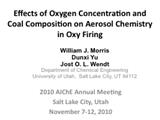 |
Effects of oxygen concentration and coal composition on aerosol chemistry in oxy firing | 2010-11-12 | aerosol chemistry; oxy firing; ICSE; coal aerosols; coal composition | Outline: 1) Objectives 2) Coals examined 3) Furnace, sampling, and analysis 4) Results 5) Conclusions. The objectives of the presentation is to provide a comparison of three different coal aerosols under two different oxy fired scenarios for predicting effects of coal composition on oxy firing. Exam... |
| 769 |
 |
Effects of partial pressure of oxygen on the stability of axial, oxy-coal, turbulent diffusion flames: Topical report task 8 | 2009-07-31 | Oxy-fuel combustion; Pulverized coal; Flue gas recirculation; CO2 sequestration; Near-burner zone environment; O2; CO2; Partial pressure of oxygen; Flame stability; Air combustion; Coal-jet ignition models; Predicting flame attachment; Retrofit; Oxy-coal combustion; Type 0 axial flames; Turbulent di... | Oxy-fuel combustion of pulverized coal with flue gas recirculation is potentially one of the few technologies that may allow CO2 sequestration technologies to be applied to existing coal-fired boilers. One issue of interest is to understand and predict the effects of the near-burner zone environment... |
| 770 |
 |
Efficient parallelization of RMCRT for large scale LES combustion simulations | 2011-06 | monte carlo; RMCRT; parallelization; large scale LES combustion; combustion simulations; radiation | At the high temperatures inherent to combustion systems, radiation is the dominant mode of heat transfer. An accurate simulation of a combustor therefore requires precise treatment of radiative heat transfer. This is accomplished by calculating the radiative-flux divergence at each cell of the discr... |
| 771 |
 |
Employment and population analysis and projections Ogden Metropolitan Area, Utah and the United States | 1963-07 | Thomas A. McLean and M r s . Connie P„ F a u l k n e r , graduate s t u d e n t s , and David L . Sutton, a senior student, in the Department of Economics, r e n d e r e d very valuable a s s i s t a n c e in the p r e p a r a t i o n of this r e p o r t. The Utah Department of Employment Se... | |
| 772 |
 |
Employment and population analysis and projections Provo metropolitan area, Utah and the United States | 1964-09 | This is the third and final report analyzing and projecting the employment profile and estimating the future population of Utah's three Metropolitan Areas Salt Lake, Ogden, and Provo--as part of a transportation study of each area by the Utah State Highway Department and local government agencies ... | |
| 773 |
 |
Employment and population analysis and projections Salt Lake Metropolitan Area, Utah and the United States | 1962-09 | Thomas A. McLean and Mrs. Connie P. Faulkner, graduate students in the Department of Economics, rendered very valuable assistance in the preparation of this report. The Utah Department of Employment Security was most cooperative and helpful in making available the necessary basic data for this stud... | |
| 774 |
 |
Employment, population, income and automobiles in Salt Lake, Ogden, Provo Metropolitan Area and State of Utah | 1966-12 | William C a r l i s l e and Michael A. Stoddard, graduate students in the Department of Economics, rendered v e r y valuable a s s i s t a n c e in the p r e p a r a tion of t h i s r e p o r t . Gregory M. Nielson, graduate student in Mathematics, a s s i s t e d in computer programming, and Iver... | |
| 775 |
 |
Ending the energy stalemate: A bipartisan strategy to meet America's energy challenges | 2004-12 | Energy; Greenhouse gas emissions; Energy supplies; Energy security; Global climate change; National energy policy; Future U.S. energy policy; Bipartisan; Oil security; Vehicle fuel economy standards; Energy efficiency; Sustainable energy; Hybrid vehicles; Natural gas; Refrigerator; Alaska natural ga... | This report recommends a revenue-neutral package of measures designed to ensure affordable and reliable supplies of energy for the twenty-first century while responding to growing concern about energy security and the risks of global climate change driven by energy-related greenhouse gas emissions. ... |
| 776 |
 |
Enefit American Oil introduction & progress update | 2012-05-15 | Enefit American Oil; EAO; unconventional fuels | 1. Introduction to Enefit American Oil 2. Overview of Development Plan 3. Progress Update 4. Estonian Shale Oil Industry Expansion |
| 777 |
 |
Energy conservation and pollution control (abstract) | Abstract | ||
| 778 |
 |
Energy development in the Uintah Basin: economic and demographic impacts | 1981-07 | This report, "Energy Developments in the Uintah Basin: Economic and Demographic Impacts," is one of aseries of reports issued by the State Planning Coordinator's Office that are designed to support comprehensive planning and the development of a Utah growth management strategy. The report is intende... | |
| 779 |
 |
Energy development on tribal lands | 2011-05-17 | unconventional fuels; energy development | Indian tribes throughout this country own a substantial amount of untapped energy resources. Energy production from tribal lands equals ten percent of the total federal onshore production of energy minerals. Indian-owned energy resources are still largely undeveloped: 1.81 million acres are being ex... |
| 780 |
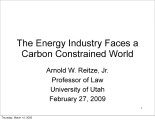 |
The energy industry faces a carbon-constrained world | 2009-02-27 | carbon regulation; energy industry; carbon control; CO2 sequestration; GHG. | Analysis of the impacts of potential frameworks for carbon regulation on the energy industry, presented at the 2009 Western U.S. Oil Sands Conference by Arnold W. Reitze, Jr., Professor, S.J. Quinney College of Law, University of Utah. |
| 781 |
 |
Energy resources map of Utah (no. 36) | 1975-05-01 | energy resources | |
| 782 |
 |
Energy resources map of Utah (no. 44) | 1974 | energy resources | Edition of 1959 of the U.S. Geological Survey, modified 1974 by the Utah Geological and Mineral Survey |
| 783 |
 |
Energy resources map of Utah (no. 68) | 1983-05 | Map 68; Utah; Energy Resources map; Gilsonite; Oil shale; Oil-impregnated rock; Geology; Oil and natural gas | |
| 784 |
 |
Engineering prospects of a field test thermal recovery of oil from tar sands Asphalt Ridge, Uintah County, Utah | 1959-04-25 | tar sand deposits; thermal recovery methods; tar sand; oil field; Asphalt Ridge | In late 1956 Sohio acquired certain interests in tar sand deposits at Asphalt Ridge a few miles west of Vernal, Utah. During 1957 and 1953 we conducted an extensive coring program to evaluate those shallower areas most susceptible to mining and air injection tests to evaluate those deeper areas most... |
| 785 |
 |
Enhanced in-situ production through fracturing | 2010-04-28 | in-situ production; fracturing; fracturing methods | Rationale For Fracturing: 1) Ultra-Low Matrix Permeability 2) Poorly Interconnected Fracture Network 3) Desire to Maximize Surface Area, Minimize Transport Distance In Matrix and Increase Conductivity of Flow Paths For Production 4) Increase Surface Area, Increase Fracture Frequency |
| 786 |
 |
The ENN UCG Progress | 2011-03-24 | UCG process; ENN group; underground coal gasification | 6th Annual International Conference & Workshop on Underground Coal Gasification, 23rd - 24th March 2011 |
| 787 |
 |
Enthalpy relations for Eastern oil shale | 1987-11 | Enthalpy relations; eastern oil shale; oil shale; oil shale process; oil shale modeling; oil shale engineering; shale enthalpy | Relations were developed that allow easy and accurate calculation of enthalpy changes during the heating, retorting, or cooling of raw, spent, or burned Eastern oil shales. The heat capacities of the mineral matter, bound water, kerogen, and char, and the heat of mineral dehydration are given by lin... |
| 788 |
 |
Environmental assessment: Tar sand in situ steam injection experiment | 1979-12 | LETC; in situ recovery of bitumen from tar sand; tar sand; bitumen | The U. S. Department of Energy - Laramie Energy Technology Center (LETC) intends to conduct a field experiment for the in situ recovery of bitumen from tar sand. The experimental site is located on a ten acre site approximately 6.5 miles West of Vernal, Utah. The operational phase of the experiment ... |
| 789 |
 |
Environmental concerns for oil sands development in Utah--serious unanswered questions | 2008-02-22 | tar sands development; tar sand; Southern Utah Wilderness Association; BLM; PEIS; EIA; tar sand recovery | Overview of environmental issues and concerns associated with potential tar sands development in Utah presented by Stephen Bloch, Conservation Director of the Southern Utah Wilderness Association. |
| 790 |
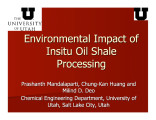 |
Environmental impact of in-situ oil shale processing | 2007-10 | in situ processing of oil shale; in situ processing; oil shale; production of oil from kerogen; oil production | The in situ processing of oil shale for the production of oil from the kerogen involves heating the shale slowly to moderate temperatures of between 3000 C and 4000 C. At this temperature, gaseous products that evolve from the oil shale are condensed and recovered. The pathways of creation of oil fr... |
| 791 |
 |
Environmental impact of the oil sands development | 2010-04-28 | unconventional fuels conference; unconventional fuels; environmental impact; oil sands development; bitumen production; oil sands; bitumen extraction; oil sands mining; global significance of oil sand resources | This presentation goes over an introduction to oil sands production and extraction, greenhouse gases, water, land disturbance, tailings, and reclamation. This presentation was given at the 2010 Unconventional Fuels Conference: Production of Fuels from Oil Shale, Oil Sands, and Coal. |
| 792 |
 |
Environmental management of Alberta's oil sands | 2009-02-27 | environmental management; oil sands; Canadian oil sands development; crude bitumen; mineable resources; in situ resorces; oil sands deposits | Analysis of the challenges and successes of environmental management of Canadian oil sands development, presented at the 2009 Western U.S. Oil Sands Conference by Preston McEachern, Head of Science, Research & Innovation, Oil Sands Environmental Management Division, Alberta Environmental, Canada. |
| 793 |
 |
Environmental technologies applicable to shale development: Integrating simulation and experiment | 2008-11-13 | oil shale technologies; oil shale; environmental technologies; shale development | Presentation given at the Utah Oil Shale Resources and Technology Update, November 13, 2008, The Leonardo, Salt Lake City, Utah. |
| 794 |
 |
Environmental, health, safety, and socioeconomic impacts associated with oil recovery from tar-sand deposits in the United States | 1981-09-12 | tar sand; tar sand resources; oil recovery; petroleum extraction | The tar-sand resources of the United States have the potential to yield as much as 36 billion barrels (bbls) of oil. The tar-sand petroleum-extraction technologies now being considered for commercialization in the United States include both surface (above-ground) systems and in situ (underground) pr... |
| 795 |
 |
Estimate of total, oil in place White Rocks Oil Properties Uintah county, Utah | 1961-12-09 | oil; petroleum recovery; heavy oil; tar; oil reserves; White Rocks Oil properties | Western Industries, Inc., is engaged in a project with the ultimate objective of recovering petroleum products from the "heavy oil" or "tar" bearing Navajo sandstone formation which is found at or near the surface on certain properties which they have acquired in Uintah County, Utah. Work on this pr... |
| 796 |
 |
Estimates and projections of low income population in Utah 1970-1985 | 1977 | This i s one in a series of projections and estimates of "target populations" defined by the Utah Department of Social Services for planning, management, and budgeting purposes. The fourteen target populations are: | |
| 797 |
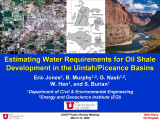 |
Estimating water requirements of oil shale development in the Uintah/Piceance Basins | 2008-03-12 | water requirements; oil shale development; water resources; oil sands | Collect geospatial data and information on water resources associated information related to oil sands and oil shale development -Conduct a regional analysis of water requirements for oil shale development incorporation urbanization, alternative energy development, and wastewater recycling/reuse -De... |
| 798 |
 |
The estimation of intercensal migration from birth-residence statistics: a study of data for the United State, 1950 and 1960 | 1968-02 | This is the seventh in a series* of technical and analytical reports issued by the Population Studies Center of the University of Pennsylvania. All except Report No. 6 are focussed upon some aspect of recent migration and urbanization in the United States. | |
| 799 |
 |
European UCG Case Study | 2011-03-21 | UCG; underground coal gasification; European UCG; case study; European trial; coal; CRIP process | UCG Training Course, March 21-22, 2011, Deloitte, London |
| 800 |
 |
Evaluating opportunities for reducing life-cycle, well-to pump GHG emissions from conventional and unconventional fuels | 2010-04-28 | unconventional fuels; GHG emissions; conventional fuels; reducing life-cycle; oil shale; oil sands; coal | Resource extraction and upgrading. |
